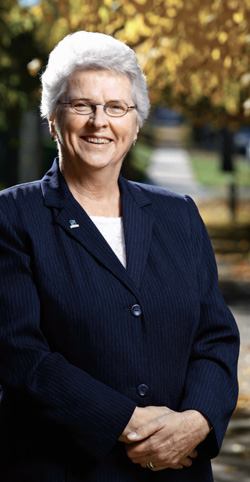That’s a hefty responsibility, considering the complexity of some of Mercy’s financing structures. “I have seen Mercy projects that involve up to 10 different funding sources,” notes Hagan of National Equity Fund. “It’s like layers of lasagna. Mercy almost never gets a plain vanilla deal.”
Case in point: The Margo and Harold Schiff Residences, a new single-room occupancy building for homeless people in Chicago’s Near North. Its nearly $18 million in funding came piecemeal from various sources, such as low-income housing tax credits, the Illinois House Development Authority, Federal Home Loan Bank Board funds, HUD grants, and more.
“In all, development on this project took about five years,” notes Cindy Holler, president of Mercy Housing Lakefront in Chicago. Even so, the 96-unit property showcases many “green features” to keep costs down and conserve resources. These include an energy-conserving metal skin, roof-mounted solar panels and wind turbines that are expected to generate up to 15 percent of the building’s energy, and a graywater treatment system.
The responsibilities of Mercy’s empowered managers extend beyond fiscal oversight. They are also able to make property-level decisions. For instance, managers are not bound to use Mercy Services Corp., the nonprofit’s management arm. And local residential services report to them—not to the management company. So far, the new system seems to be working.
MIX IT UP
In the end, no amount of operational efficiency, leadership, or decentralization would save Mercy, if they didn’t establish a greater mix of housing, Narasimhan told the company. Without abandoning those below 50 percent of AMI, he urged more participation in mixed-income projects and an increased emphasis on for-sale housing. “Why shouldn’t Mercy help create wealth for its residents, which is what ownership does?” Narasimhan adds.
Mercy is taking the advice seriously. In Denver‘s sought-after City Park South area, people with incomes of up to 95 percent of AMI have snapped up Mercy Housing’s Legacy condominiums, where one-bedroom units sell for $111,000. The land for the four-story, 33-unit building came from Opus Northwest, which is building luxury housing towers in the area and was looking for a nonprofit partner to help it fulfill the city’s mandated affordable housing component.
“Legacy is a great example of a partnership between a large for-profit builder and a nonprofit,” says Brad Buchanan, the project’s general contractor. “It’s an excellent model for the mixed-income developments that will make affordable housing more acceptable to communities.”
In California, Mercy is planning its first condo project in Oxnard. Jane Graf, president of Mercy Housing California, the nonprofit’s largest division with more than 6,000 units in its rental portfolio, sees this as indicative of a shift toward a new strategy, one where Mercy will assemble larger tracts of land, use a portion for its own projects, and sell the rest to for-profit developers for market-rate housing.
Also on the for-sale front, Mercy, over the past year, has moved aggressively to buy and rehab more than 100 foreclosed HUD properties in Denver, selling the units to buyers with incomes of up to 115 percent of AMI (the average is 80 percent). “HUD has told us that we are the national leader in this program,” says Jennifer Erixon, president of Mercy Housing Colorado. Mercy hopes to expand this effort to other cities, such as Atlanta.
From all indications, this and the other changes are energizing the Mercy Housing staff, who see the new strategy as essential if Mercy is to continue to play a dominant role in addressing what they see as a looming crisis in affordable housing. “It’s a train wreck waiting to happen,” Banks says. “And it will take a paradigm shift to address it.”
Lawrence D. Maloney is a freelance writer based in Ashland, Mass.
LEADERSHIP LESSONS:
SISTER LILLIAN MURPHY
- First “real” job: Billing clerk at a wholesale grocery company.
- Best business decision: Engaging Beekman Associates to do an organizational assessment that led to changing our business model to more effectively meet our mission.
- Worst business decision: Hiring for a key position too quickly. Wait for the right person, even if it takes longer than you think it should.
- Your ideal leader: Someone who listens, is decisive, and is willing to take risks.
- Best advice someone gave you: If you want to be successful, surround yourself with excellence.
- Your greatest challenge as a leader: Integrating the best of the for-profit and nonprofit worlds within Mercy Housing.
- Favorite quote: “Worry is like a rocking chair. It will give you something to do but it won’t get you anywhere.”
—Humorist Erma Bombeck
